
 St Mary
the Virgin
|
|
|
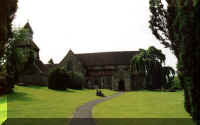
|
|
1 |
|
1. General view of the exterior of the
church from the south. The detached campanile
(2) stands at the left of the picture.
|
|
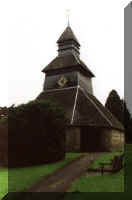
|
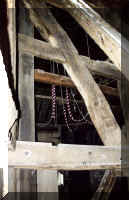 |
|
2 |
3 |
|
2. The detached campanile.
This is one of seven in the County, and is reckoned to
be the finest. There is no other campanile in
England exactly like it. Structurally it is
related to the stave churches of Norway and the bell
houses of Sweden. It stands north of
the chancel and its irregular hexagonal shape is some
45 ft in diameter, with a high truncated pyramidal
roof. The second and third stages are of the same
shape, only smaller, the sides being of
weatherboarding. The walls of the lowest stage
are of stone, with old stone tiles, the upper roofs
being tiled. 3. The massive
timber frame within is thought to have been a
temporary bell tower, being constructed in the early
13th century. This was added to and cross-braced
later, and the ambulatory around the central frame was
added sometime in the 15th and 16th centuries. This
again was remodelled in the 17th Century. Its walls
are thick, with narrow loop-holes, suggesting that it
was also used as a place of refuge. Major
restoration work was undertaken in 1983-84, which the
Department of the Environment funded entirely, at
which time further evidence of the dates of
construction was obtained. It is suggested that the
original massive timbers might have come from an old
castle or fortified manor house which once stood on
the site of the present Court House Farm adjoining the
church, and behind the remains of the moat which can
still be seen adjoining the churchyard.
|
|
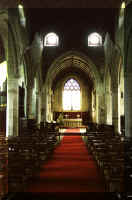
|
|
4 |
|
4. The nave looking
east.
|
|
|
|
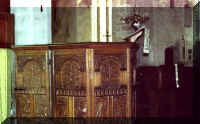
|
|
5 |
|
5. The Jacobean pulpit,
showing the carvings of the mythical human-headed
dragons.
|
|

|
|
6 |
|
6. The stained glass window
over the altar in the south transept. Much if
the mediaeval glass in the church was destroyed during
the Civil War. This rather beautiful stained
glass window is in memory of Susan catherine, wife of
Thomas Gornall, formerly a doctor in Pembridge.
|
|
|
History
of the village and church
Pembridge was once a thriving Market Town. The
Mortimer family, whom followed the de Pennebrugge family - hence
it's name - made Pembridge a borough, and, in 1240, secured a
Royal Charter which gave the own a market and rights to hold an
annual fair. The Market Hall is early 16th century, there are
several cottages and other buildings dating from the 14th century,
and a wealth of other dwellings all constructed with timber
frames, dating from the 16th and 17th centuries.
There is no real record of the previous Norman
church which once stood on the site of the present church,
although one or two decorated stones now in the detached belfry
are thought to have come from it. Likewise, two built-up
12th century arches remain in the north and south walls of the
chancel. The whole of the present church dates from between 1320
and 1360, work having been delayed by decimation of the labour
caused by the Black Death of 1349.
The lofty arches of the nave are octagonal, and
above the arcades are clerestories with their original circular
windows. Two further such windows face east, across the chancel
roof.
At the crossing are the Jacobean Pulpit, Lectern
and Reading Desk. The intricate carving here shows Herefordshire
craftsmen at their best. The Pulpit is heptagonal and, like
the Lectern, portrays in panels mythical figures and designs
derived from nature. The panel of the Reading Desk is possibly
much older - perhaps from a former pulpit.
The alter rail are also Jacobean
|
|
GALLERY
The Church Guide states:
|
In the angle between
the Chancel and the South Transept is a turret.
Through this turret runs a stone spiral staircase
which led to the rood loft or singing gallery.
High up the turret can be seen the doorway, protected
with bars, that gave access to the gallery from the
staircase."
|
|
|
|
Dove's reference for the bells |
| Pembridge,
Herefordshire, S Mary (GF), 5, 16cwt in F.
Detached tower.
|
|
|
ACCESS |
| Map reference : SO391580
Apparently open during daylight hours.
|
|
|
Photographs: ©
Edwin Macadam
2002
|
|
Please see our
Home Page
for important copyright notice |

|
|

|
|
|

|
|
|
|
|
SEARCH THIS SITE |
|
|
This
site has been constructed by, and remains the copyright of,
its authors,
Edwin and Sheila Macadam,
Shelwin, 30, Eynsham Road, Botley,
Oxford OX2 9BP
|
|
| ©
July 2001 -
|
|







